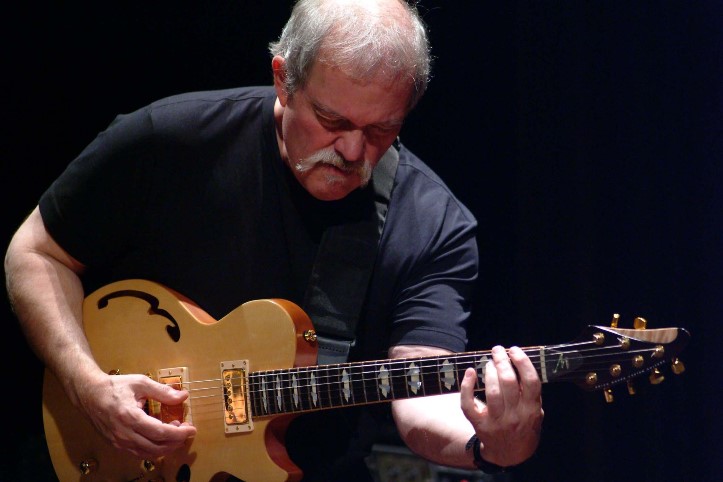

 |
RIP John Abercrombie |
|
John Abercrombie has created one of the more elegant jazz guitar albums
that you will hear. He refers to his new CD
The Third Quartet as Chamber
Jazz, which incorporates the violin, guitar and drums. For the most part
The Third Quartet represents
a departure in musical style from some of Abercrombie’s more recent
projects such as Cat ‘N’ Mouse
(2002), Class Trip (2004)
and
“My music is (usually) free in the sense that it is not mapped out, but
on the current record it is quite structured. Almost all of the songs
(on the new CD) have very specific chord progressions and melodies. They
are songs, versus being little rhymes or ideas, such as was the case on
the previous albums Cat ‘N’ Mouse
and Class Trip. On
Cat ‘N’ Mouse, there were a
couple of pieces that were totally improvised, and there were a couple
of pieces that were what I would call setups. They were little ideas
that setup areas for improvising. They are not structured pieces. The
new CD is very structured and that is probably why it sounds prettier.
It is really song oriented,” says Abercrombie.
The guitar virtuoso notes that the opening track “Banshee” is the only
song from The Third Quartet
that is very wide open. “It is a simple melody which I wrote the day
before the record. I didn’t even bother writing it down on paper. I just
played it for Mark Feldman and he learned it by ear.
I knew the basic direction in which I wanted the piece to go, and
we recorded it in one take. The rest of the CD is very structured,” he
says.
Abercrombie says of his music, “The only difficult part about my tunes
is the harmonies. All you need to pay attention to with my tunes is the
harmony and the way that the rhythm moves. There is only one tune on
The Third Quartet that I
consider to be a hard tune, it is called “Trace,” a medium tempo waltz
with a lot of chords.”
The
Third Quartet was recorded in
typical Abercrombie fashion with the John Abercrombie Quartet comprised
of himself, Joey Baron (drums), Mark Feldman (violin) and Marc Johnson
(bass) rehearsing only once before heading into the studio.
“Generally speaking my (recorded) projects have been done with one day
rehearsals, and then maybe a day off between the rehearsal and the
recording. A lot of decisions occur while recording in the studio. I
rely a lot on the input of the other musicians (concerning) how to do a
tune, what kind of feel it should have or how it should be structured.
My charts are not really charts as much as they are sheets of tunes,” he
says.
Continuing Abercrombie says, “I plan very well before I go into the
studio. (Some of) the songs that I write are a little more structured,
while others are a little more abstract. Usually I put together ten or
so different types of compositions that I would like to try. I am not
married to any of them.”
Abercrombie used four guitars during the recording of
The Third Quartet, including
a Taylor acoustic for the closing ballad “Fine,” for which he
multitracked himself playing, and then did some overdubbing. He also
used a big-bodied arch top guitar and a custom Les Paul.
Abercrombie explains how Ornette Coleman’s “Round Trip” wound up on the
CD, “I originally had another Ornette tune in mind called “Rambling.” I
looked it (“Rambling”) up and when I printed it out, at the bottom of
the page was this tune “Round Trip.” I played “Rambling,” which I really
liked, but I thought I would take a look at this other (Ornette) tune
(“Round Trip”). I liked it even better because it has a swing Jazz feel,
but it is open. There are no chords, there is no structure. It is a lot
of fun.”
The prominent role given to Mark Feldman’s violin is what distinguishes
the music of The Third Quartet
from other Jazz guitar albums. His bow evokes pastoral images without
becoming languid.
“My connection to Mark Feldman goes back almost twenty years. He was a
student at the
Turning his attention to drummer Joey Baron, Abercrombie says, “Joey’s
first recording with me was on
Cat ‘N’ Mouse, and he has been on the last three recordings. Joey is
the perfect choice for my current band, and there is no doubt about it.
He can play Bebop and free Jazz.”
Concerning bassist Marc Johnson, you might say that Abercrombie is not
only a friend and colleague, but also a fan, “Marc leaves so much space
and he leaves such a beautiful sound.”
“I don’t like to say that I am expanding musical boundaries because that
is being a little full of myself,” says Abercrombie, and yet despite his
modesty that is exactly what he has been doing for most of his career.
“I am still experimenting, trying to write different kinds of songs,
trying to push myself into areas that are more expressive and not just
guitar like. I have never been concerned with just being an amazing
technician on the guitar. To me it is more important to have the music
come first, and have the technique serve the music. You develop
technique to accommodate what you are hearing, versus just sitting down
and becoming a virtuoso guitar player.
When one delves into Abercrombie’s musical background it does not take
look to realize where the inspiration to push out the boundaries stems
from. His mentors and fellow musicians form an eclectic group.
“I am steeped in the tradition of Wes Montgomery, Barney Kessel and Jim
Hall. These were all great guitar players that I grew up listening to,”
he says.
Abercrombie reflects upon the evolution of his music, “I think what
happened to me in the late sixties when fusion music started to hit and
Jazz musicians got interested in different kinds of music (such as) Rock
and Indian there was a lot of cross cultural stuff flying through the
air. I got wrapped up in that. I got involved with music effects on the
guitar, and trying to make it sound at times almost unlike a guitar.
I was also influenced by classical music and people such as Ralph Towner
who studied in Vienna and plays nylon string guitar.
He turned me on to a little more modern harmony, a more classical
approach to playing the instrument and improvising.”
Abercrombie concedes that he pushes the boundaries, “You start to put
all of these things together, and I guess I am pushing boundaries in
directions that wouldn’t always be associated with the guitar.”
Abercrombie he is also influenced by how other instrumentalists who are
not guitar players approach their music.
Abercrombie’s early tutelage in the music industry came through
performing with the likes of Johnny “Hammond” Smith in clubs on the
Chitlin’ Circuit, venues where African Americans were readily accepted,
in a time when racial discrimination often prevented them from entering
establishments owned by white people.
Commenting on being one of the few white performers in those clubs
Abercrombie says, “I was almost totally accepted. I very rarely ran
across any tension. As soon as people knew that I was a guitar player
and that I was playing at the Count Basie Lounge with Johnny “
I would take the train from midtown Manhattan where I was staying, over
to 130 th street, or wherever it was. I would have to walk
seven or eight blocks to get to the Count Basie Lounge and along the way
people would say to me, ‘Hey where are you going with that guitar?’ I
would say, ‘I’m working over at Count Basie’s.’ It was like freedom to
be included in the culture. The fact that I was a Jazz musician (seemed
to) preclude or erase the fact that I was white. It really didn’t seem
to matter, and I was always supported by the musicians that I met in
these clubs, by the people who would egg me on to play. If they liked
what I was playing they would encourage me verbally.”
His ability to cross cultural boundaries has continued throughout the
years and today John Abercrombie is a favorite on the European jazz
circuit playing in countries that include Editor's Note: While John Abercrombie may have left this world his spirit, legacy and influence will undoubtely live on for many if not all generations of guitarists to come. It became obvious to this writer during the course of our conversation that I was talking to a musical genius and I held my breath hoping that I would not embarrass myself with the questions that I was asking. For his part, John Abercrombie was always gracious to me. RIP
|